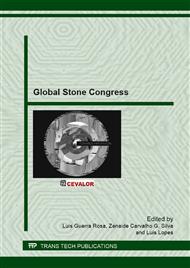p.173
p.183
p.189
p.197
p.205
p.212
p.220
p.231
p.239
"Schist" from Trás-os-Montes and Alto Douro (NE of Portugal): Potential Use as Natural Stone
Abstract:
The main purpose of this work was to increase the knowledge about the geological resources of Trás-os-Montes and Alto Douro region (TMAD), particularly about their “schists” (slate, phyllite and schist), due to the economic and social effects that their mining and processing can have, not only on the local economy, but also on a national level. This work presents the results of the study conducted on “schists” from TMAD, aiming for their use as natural stone. Special emphasis is given on the results obtained from the following physical and mechanical tests: compressive strength, flexural strength, apparent density, open porosity, water absorption, abrasion resistance and resistance to ageing by thermal shock. These tests were determinant to define the most suitable applications for each schistose stone that was studied, taking into account the existing groups of natural stone products. For defining the recommended applications for each “schist”, European standards for natural stone products were considered, as well as technical specifications that exist in some European countries, which were the basis for the establishment of a proposal of technical specifications for Portugal, already published by one of the authors of this work.
Info:
Periodical:
Pages:
205-211
Citation:
Online since:
April 2013
Price:
Сopyright:
© 2013 Trans Tech Publications Ltd. All Rights Reserved
Share:
Citation:


